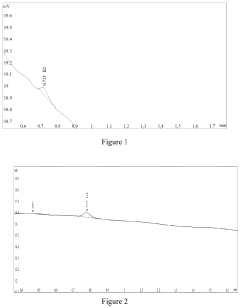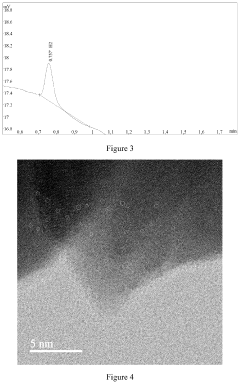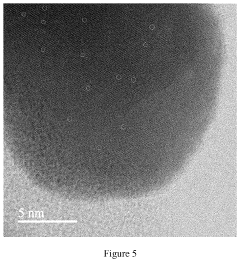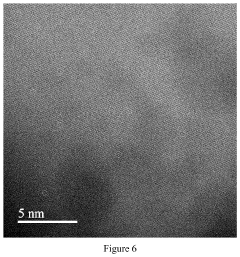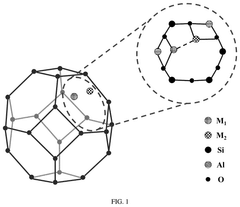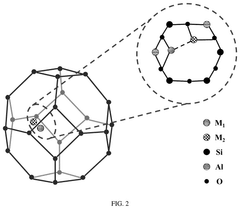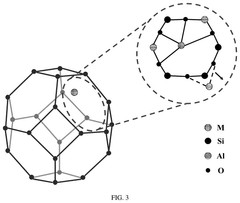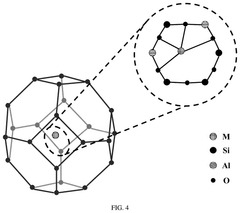What Regulatory Challenges Face Single-Atom Catalysis Technologies?
OCT 15, 20259 MIN READ
Generate Your Research Report Instantly with AI Agent
Patsnap Eureka helps you evaluate technical feasibility & market potential.
Single-Atom Catalysis Background and Objectives
Single-atom catalysis (SAC) represents a revolutionary frontier in heterogeneous catalysis that has emerged over the past decade. This innovative approach involves dispersing individual metal atoms onto suitable supports, maximizing atomic efficiency while delivering exceptional catalytic performance. The concept was first formally introduced in 2011, though earlier studies had observed similar phenomena without explicitly defining it as SAC.
The evolution of SAC technology has been driven by advances in materials science, nanotechnology, and characterization techniques. Early developments focused primarily on noble metals like platinum and palladium, while recent years have witnessed expansion to non-noble metals such as iron, cobalt, and nickel, significantly reducing potential costs and resource constraints.
The primary objective of SAC research is to develop highly efficient catalysts that minimize metal usage while maximizing catalytic activity, selectivity, and stability. This aligns with green chemistry principles and addresses sustainability challenges in industrial catalysis. By utilizing individual atoms rather than nanoparticles, SAC technologies can potentially reduce precious metal consumption by orders of magnitude.
Current technical goals include improving synthesis methods for industrial-scale production, enhancing catalyst stability under harsh reaction conditions, and expanding the range of catalytic reactions where SACs demonstrate superior performance. Researchers aim to develop standardized characterization protocols to accurately identify and quantify single-atom species, which remains challenging due to their extremely low concentration and atomic dispersion.
The regulatory landscape surrounding SAC technologies is complex and evolving. As an emerging technology, SAC faces uncertainties regarding classification under existing chemical and nanomaterial regulations. The atomic-scale nature of these materials creates unique challenges for risk assessment frameworks that were primarily designed for conventional materials or larger nanoparticles.
Future development trajectories focus on multifunctional SACs that can catalyze cascade reactions, computational approaches to predict optimal metal-support combinations, and in-situ/operando characterization techniques to understand dynamic structural changes during catalytic cycles. The field is moving toward rational design principles rather than empirical discovery methods.
The convergence of SAC with other advanced technologies, such as artificial intelligence for materials discovery and process optimization, promises to accelerate development and implementation across various industrial sectors, including energy conversion, environmental remediation, and fine chemical synthesis.
The evolution of SAC technology has been driven by advances in materials science, nanotechnology, and characterization techniques. Early developments focused primarily on noble metals like platinum and palladium, while recent years have witnessed expansion to non-noble metals such as iron, cobalt, and nickel, significantly reducing potential costs and resource constraints.
The primary objective of SAC research is to develop highly efficient catalysts that minimize metal usage while maximizing catalytic activity, selectivity, and stability. This aligns with green chemistry principles and addresses sustainability challenges in industrial catalysis. By utilizing individual atoms rather than nanoparticles, SAC technologies can potentially reduce precious metal consumption by orders of magnitude.
Current technical goals include improving synthesis methods for industrial-scale production, enhancing catalyst stability under harsh reaction conditions, and expanding the range of catalytic reactions where SACs demonstrate superior performance. Researchers aim to develop standardized characterization protocols to accurately identify and quantify single-atom species, which remains challenging due to their extremely low concentration and atomic dispersion.
The regulatory landscape surrounding SAC technologies is complex and evolving. As an emerging technology, SAC faces uncertainties regarding classification under existing chemical and nanomaterial regulations. The atomic-scale nature of these materials creates unique challenges for risk assessment frameworks that were primarily designed for conventional materials or larger nanoparticles.
Future development trajectories focus on multifunctional SACs that can catalyze cascade reactions, computational approaches to predict optimal metal-support combinations, and in-situ/operando characterization techniques to understand dynamic structural changes during catalytic cycles. The field is moving toward rational design principles rather than empirical discovery methods.
The convergence of SAC with other advanced technologies, such as artificial intelligence for materials discovery and process optimization, promises to accelerate development and implementation across various industrial sectors, including energy conversion, environmental remediation, and fine chemical synthesis.
Market Demand Analysis for SAC Technologies
The global market for Single-Atom Catalysis (SAC) technologies is experiencing significant growth driven by increasing demand for sustainable and efficient catalytic processes across multiple industries. Current market analysis indicates that the chemical manufacturing sector represents the largest application segment, with petroleum refining and environmental remediation following closely behind. These industries are actively seeking alternatives to traditional catalysts that require less precious metal content while maintaining or improving catalytic performance.
The pharmaceutical industry has emerged as a rapidly expanding market for SAC technologies, particularly in the synthesis of complex drug molecules where high selectivity and reduced waste generation are critical factors. Market research suggests that pharmaceutical companies are willing to invest in advanced catalytic technologies that can simplify multi-step synthesis processes and reduce production costs while meeting stringent regulatory requirements for product purity.
Energy transition initiatives worldwide are creating substantial market opportunities for SAC technologies in renewable energy applications. Hydrogen production, fuel cells, and CO2 conversion processes all benefit from the unique properties of single-atom catalysts. The push toward green hydrogen production has particularly accelerated interest in SAC solutions that can reduce or eliminate platinum group metal usage while maintaining efficiency.
Environmental regulations are simultaneously creating market pressure and opportunity. Stringent emission standards in automotive and industrial sectors are driving demand for more efficient catalytic converters and pollution control systems. SAC technologies offer potential solutions for NOx reduction, volatile organic compound (VOC) abatement, and other environmental applications with potentially lower material costs than conventional catalysts.
From a regional perspective, Asia-Pacific represents the fastest-growing market for SAC technologies, with China leading research and commercial development efforts. North America and Europe maintain strong positions in high-value applications, particularly in pharmaceutical and specialty chemical sectors where performance advantages outweigh cost considerations.
Market barriers include concerns about long-term stability of single-atom catalysts under industrial conditions and scalability challenges. End-users express hesitation about adopting novel catalytic technologies without extensive validation data, creating a "chicken-and-egg" problem for technology developers seeking to establish commercial traction.
Despite these challenges, market forecasts remain optimistic. The combination of performance advantages, potential cost benefits through reduced precious metal usage, and alignment with sustainability goals positions SAC technologies favorably in the evolving catalysis landscape. Strategic partnerships between academic institutions, technology developers, and end-users are emerging as a key market development strategy to accelerate commercial adoption and address regulatory hurdles.
The pharmaceutical industry has emerged as a rapidly expanding market for SAC technologies, particularly in the synthesis of complex drug molecules where high selectivity and reduced waste generation are critical factors. Market research suggests that pharmaceutical companies are willing to invest in advanced catalytic technologies that can simplify multi-step synthesis processes and reduce production costs while meeting stringent regulatory requirements for product purity.
Energy transition initiatives worldwide are creating substantial market opportunities for SAC technologies in renewable energy applications. Hydrogen production, fuel cells, and CO2 conversion processes all benefit from the unique properties of single-atom catalysts. The push toward green hydrogen production has particularly accelerated interest in SAC solutions that can reduce or eliminate platinum group metal usage while maintaining efficiency.
Environmental regulations are simultaneously creating market pressure and opportunity. Stringent emission standards in automotive and industrial sectors are driving demand for more efficient catalytic converters and pollution control systems. SAC technologies offer potential solutions for NOx reduction, volatile organic compound (VOC) abatement, and other environmental applications with potentially lower material costs than conventional catalysts.
From a regional perspective, Asia-Pacific represents the fastest-growing market for SAC technologies, with China leading research and commercial development efforts. North America and Europe maintain strong positions in high-value applications, particularly in pharmaceutical and specialty chemical sectors where performance advantages outweigh cost considerations.
Market barriers include concerns about long-term stability of single-atom catalysts under industrial conditions and scalability challenges. End-users express hesitation about adopting novel catalytic technologies without extensive validation data, creating a "chicken-and-egg" problem for technology developers seeking to establish commercial traction.
Despite these challenges, market forecasts remain optimistic. The combination of performance advantages, potential cost benefits through reduced precious metal usage, and alignment with sustainability goals positions SAC technologies favorably in the evolving catalysis landscape. Strategic partnerships between academic institutions, technology developers, and end-users are emerging as a key market development strategy to accelerate commercial adoption and address regulatory hurdles.
Current Regulatory Landscape and Technical Barriers
The regulatory landscape for single-atom catalysis (SAC) technologies remains fragmented globally, with significant variations across different jurisdictions. In the United States, the Environmental Protection Agency (EPA) regulates catalytic materials primarily through the Toxic Substances Control Act (TSCA), which requires pre-manufacturing notifications for new chemical substances. However, the unique properties of single-atom catalysts often place them in regulatory gray areas, as existing frameworks were designed for conventional bulk catalysts rather than atomic-scale materials.
The European Union employs a more precautionary approach through REACH (Registration, Evaluation, Authorization and Restriction of Chemicals) regulations, requiring extensive safety data for novel materials. Single-atom catalysts frequently encounter challenges in classification under these regulations due to their hybrid nature—combining aspects of homogeneous and heterogeneous catalysis—leading to uncertainty regarding which regulatory pathway applies.
In Asia, particularly China and Japan, regulatory frameworks are evolving rapidly to accommodate advanced materials, but specific provisions for single-atom catalysts remain underdeveloped. This regulatory inconsistency creates significant barriers for international commercialization and technology transfer.
Technical barriers compound these regulatory challenges. The lack of standardized characterization methods for single-atom catalysts impedes regulatory assessment. Current analytical techniques struggle to provide definitive evidence of single-atom dispersion at industrial scales, creating uncertainty in quality control and regulatory compliance verification.
Safety assessment protocols present another significant barrier. Traditional toxicological testing frameworks may not adequately capture the unique biological interactions of single-atom catalysts, which can exhibit different bioavailability and reactivity compared to their bulk counterparts. This knowledge gap complicates hazard classification and risk assessment procedures required by regulatory bodies.
Lifecycle analysis requirements pose additional challenges. Regulators increasingly demand comprehensive environmental impact assessments covering production, use, and disposal phases. For single-atom catalysts, tracking the fate of dispersed metal atoms throughout the product lifecycle presents formidable technical difficulties, particularly regarding potential leaching or transformation during use or disposal.
Intellectual property protection intersects with regulatory compliance in complex ways. The novelty of single-atom catalysis technologies has generated a rapidly expanding patent landscape, but regulatory uncertainty regarding classification and safety requirements can undermine IP value and complicate licensing agreements across jurisdictions.
These regulatory and technical barriers collectively slow commercialization timelines and increase development costs for single-atom catalysis technologies, despite their promising environmental and efficiency benefits. Industry stakeholders and academic researchers are increasingly calling for harmonized international standards and regulatory frameworks specifically addressing the unique properties and applications of atomic-scale catalytic materials.
The European Union employs a more precautionary approach through REACH (Registration, Evaluation, Authorization and Restriction of Chemicals) regulations, requiring extensive safety data for novel materials. Single-atom catalysts frequently encounter challenges in classification under these regulations due to their hybrid nature—combining aspects of homogeneous and heterogeneous catalysis—leading to uncertainty regarding which regulatory pathway applies.
In Asia, particularly China and Japan, regulatory frameworks are evolving rapidly to accommodate advanced materials, but specific provisions for single-atom catalysts remain underdeveloped. This regulatory inconsistency creates significant barriers for international commercialization and technology transfer.
Technical barriers compound these regulatory challenges. The lack of standardized characterization methods for single-atom catalysts impedes regulatory assessment. Current analytical techniques struggle to provide definitive evidence of single-atom dispersion at industrial scales, creating uncertainty in quality control and regulatory compliance verification.
Safety assessment protocols present another significant barrier. Traditional toxicological testing frameworks may not adequately capture the unique biological interactions of single-atom catalysts, which can exhibit different bioavailability and reactivity compared to their bulk counterparts. This knowledge gap complicates hazard classification and risk assessment procedures required by regulatory bodies.
Lifecycle analysis requirements pose additional challenges. Regulators increasingly demand comprehensive environmental impact assessments covering production, use, and disposal phases. For single-atom catalysts, tracking the fate of dispersed metal atoms throughout the product lifecycle presents formidable technical difficulties, particularly regarding potential leaching or transformation during use or disposal.
Intellectual property protection intersects with regulatory compliance in complex ways. The novelty of single-atom catalysis technologies has generated a rapidly expanding patent landscape, but regulatory uncertainty regarding classification and safety requirements can undermine IP value and complicate licensing agreements across jurisdictions.
These regulatory and technical barriers collectively slow commercialization timelines and increase development costs for single-atom catalysis technologies, despite their promising environmental and efficiency benefits. Industry stakeholders and academic researchers are increasingly calling for harmonized international standards and regulatory frameworks specifically addressing the unique properties and applications of atomic-scale catalytic materials.
Current Compliance Approaches and Solutions
01 Preparation methods of single-atom catalysts
Various methods are employed to prepare single-atom catalysts with high dispersion and stability. These include wet chemical synthesis, atomic layer deposition, and high-temperature treatment processes. The preparation techniques focus on anchoring individual metal atoms onto suitable supports while preventing aggregation. These methods enable precise control over the atomic structure and electronic properties of the catalysts, resulting in materials with enhanced catalytic performance.- Single-atom catalyst preparation methods: Various methods for preparing single-atom catalysts have been developed, including atomic layer deposition, wet chemistry approaches, and high-temperature treatments. These methods focus on anchoring individual metal atoms onto support materials with precise control over dispersion and stability. The preparation techniques often involve the use of specific precursors and controlled reaction conditions to achieve isolated atomic sites with optimal catalytic performance.
- Support materials for single-atom catalysts: Different support materials play a crucial role in stabilizing single metal atoms and enhancing their catalytic properties. Common supports include carbon-based materials (graphene, carbon nanotubes), metal oxides, and metal-organic frameworks (MOFs). The interaction between the single metal atoms and the support affects the electronic structure and catalytic behavior of the active sites, leading to improved activity, selectivity, and stability in various catalytic reactions.
- Single-atom catalysts for energy applications: Single-atom catalysts have shown promising performance in energy-related applications such as hydrogen evolution, oxygen reduction/evolution reactions, and CO2 reduction. These catalysts offer high atom efficiency and unique electronic properties that enable efficient energy conversion processes. The atomically dispersed active sites provide well-defined coordination environments that can be tailored for specific energy conversion reactions with reduced noble metal usage.
- Single-atom catalysts for environmental applications: Single-atom catalysts demonstrate exceptional performance in environmental remediation processes including pollutant degradation, CO oxidation, and NOx reduction. Their high surface-to-volume ratio and unique electronic properties enable efficient catalytic conversion of environmental pollutants under mild conditions. The atomically dispersed active sites offer enhanced selectivity and activity compared to conventional nanoparticle catalysts, making them promising candidates for green chemistry applications.
- Characterization and theoretical studies of single-atom catalysts: Advanced characterization techniques and theoretical calculations are essential for understanding the structure-property relationships in single-atom catalysts. Methods such as aberration-corrected electron microscopy, X-ray absorption spectroscopy, and density functional theory calculations provide insights into the coordination environment, electronic structure, and reaction mechanisms of single-atom active sites. These studies help guide the rational design of more efficient single-atom catalysts with optimized performance for specific applications.
02 Support materials for single-atom catalysts
Different support materials play crucial roles in stabilizing single atoms and influencing their catalytic properties. Common supports include carbon-based materials (graphene, carbon nanotubes), metal oxides, and nitrogen-doped porous structures. The interaction between the single metal atoms and the support affects the electronic structure and coordination environment, which directly impacts catalytic activity and selectivity. Novel support designs focus on creating defect sites or specific binding environments to anchor single atoms effectively.Expand Specific Solutions03 Applications in energy conversion and storage
Single-atom catalysts demonstrate exceptional performance in various energy-related applications, including hydrogen evolution reaction, oxygen reduction reaction, and CO2 conversion. Their high atom utilization efficiency and unique electronic properties enable lower energy barriers for critical reactions in fuel cells, electrolyzers, and batteries. These catalysts offer promising alternatives to traditional noble metal catalysts, providing higher activity while using significantly less precious metal content.Expand Specific Solutions04 Environmental applications and pollutant removal
Single-atom catalysts show remarkable efficiency in environmental remediation processes, including the degradation of organic pollutants, NOx reduction, and CO oxidation. Their well-defined active sites enable selective transformations with minimal side reactions. The high surface exposure of catalytic centers allows for efficient interaction with environmental contaminants, making these materials valuable for air and water purification technologies. Recent developments focus on designing single-atom catalysts that can operate under ambient conditions with high stability.Expand Specific Solutions05 Characterization and theoretical modeling of single-atom catalysts
Advanced characterization techniques and theoretical modeling approaches are essential for understanding the structure-property relationships in single-atom catalysts. Methods such as aberration-corrected electron microscopy, X-ray absorption spectroscopy, and density functional theory calculations provide insights into the coordination environment, oxidation state, and reaction mechanisms at the atomic level. These fundamental studies guide the rational design of more efficient single-atom catalysts by establishing correlations between atomic structure and catalytic performance.Expand Specific Solutions
Key Regulatory Bodies and Industry Stakeholders
Single-atom catalysis technology is currently in an early growth phase, characterized by rapid scientific advancement but limited commercial deployment. The global market for advanced catalysts is projected to reach $35 billion by 2025, with single-atom catalysts representing an emerging segment. Technologically, research institutions like Johns Hopkins University, Columbia University, and Chinese Academy of Sciences are leading fundamental research, while companies including SK Innovation, Honda Motor, and Kaneka Corp are advancing industrial applications. Regulatory challenges include undefined safety protocols, inconsistent international standards, and intellectual property protection issues. The technology faces particular scrutiny regarding nanomaterial environmental impact assessment, catalyst characterization standardization, and scale-up validation requirements across different jurisdictions.
The Trustees of Columbia University in The City of New York
Technical Solution: Columbia University has developed a regulatory-conscious approach to single-atom catalysis through their "sustainable atomic dispersion" technology. Their methodology addresses key regulatory challenges by implementing green chemistry principles in SAC synthesis, using benign solvents and reducing hazardous waste generation. Columbia's technology features a novel stabilization approach that prevents atom aggregation during catalytic reactions, addressing regulatory concerns about catalyst classification and potential changes during use[2]. They've established comprehensive analytical protocols combining multiple characterization techniques to definitively identify and quantify single-atom species, providing crucial data for regulatory submissions. Their approach includes systematic toxicological assessment of their SACs, examining potential environmental and health impacts through standardized leaching tests and bioaccumulation studies. Columbia has also developed specialized protocols for evaluating catalyst performance degradation and potential byproduct formation during extended use, addressing regulatory concerns about long-term safety. Their regulatory strategy includes proactive engagement with regulatory bodies to establish appropriate frameworks for this emerging technology class, particularly focusing on applications in pharmaceutical synthesis where regulatory scrutiny is especially high[5].
Strengths: Strong focus on green chemistry principles aligns well with evolving regulatory frameworks; comprehensive toxicological assessment approach addresses key safety concerns. Weaknesses: Academic research focus may present challenges in scaling to industrial production while maintaining regulatory compliance; potential gaps in long-term stability data could delay regulatory approvals for certain applications.
California Institute of Technology
Technical Solution: California Institute of Technology (Caltech) has developed a regulatory-focused approach to single-atom catalysis through their "precision atomic architecture" technology. Their methodology addresses regulatory challenges by implementing atomic-scale precision manufacturing techniques that ensure consistent single-atom dispersion, crucial for regulatory reproducibility requirements. Caltech has pioneered advanced characterization protocols combining aberration-corrected electron microscopy with synchrotron-based X-ray absorption spectroscopy to provide definitive evidence of single-atom structures, addressing regulatory concerns about material classification[1]. Their technology includes innovative encapsulation strategies that prevent metal leaching and migration, directly addressing safety concerns raised by regulatory bodies regarding potential contamination in end products. Caltech has also developed comprehensive life cycle assessment protocols specifically for SACs to evaluate environmental impacts from production through disposal, aligning with emerging regulatory frameworks for sustainable chemistry. Their regulatory strategy includes extensive collaboration with US regulatory agencies to establish appropriate testing protocols and safety standards for this emerging catalyst class[3].
Strengths: Strong scientific foundation and characterization capabilities provide robust evidence for regulatory submissions; established relationships with US regulatory bodies facilitate approval processes in North American markets. Weaknesses: Complex encapsulation technologies may face additional regulatory scrutiny regarding novel materials; potential challenges in scaling production while maintaining regulatory compliance could limit commercial applications.
Critical Patents and Literature on SAC Regulation
Method for producing hydrogen molecules by means of energy radiation
PatentPendingUS20240043270A1
Innovation
- A composite catalyst comprising nano-base structures and atomic sites, such as single atoms or atomic clusters of specific chemical elements, is used to decompose hydrogen-containing sources like water through energy radiation, optimizing the plasmon effect and single atom catalysis for enhanced efficiency and stability.
Single-atom catalyst with molecular sieve-confined domains, preparation method and application thereof
PatentPendingUS20240399346A1
Innovation
- A single-atom catalyst with molecular sieve-confined domains is developed, where bimetallic ions are uniformly dispersed within the molecular sieve using a post-processing or in-situ synthesis method, leveraging oxygen vacancies and aluminum-rich sites for enhanced NO adsorption and dissociation, improving catalytic activity and stability.
Environmental Impact Assessment Framework
The Environmental Impact Assessment Framework for single-atom catalysis (SAC) technologies requires a comprehensive approach that balances innovation with ecological responsibility. This framework must address the unique characteristics of SAC, which operates at the atomic scale with potentially different environmental footprints compared to traditional catalytic processes.
The assessment begins with lifecycle analysis specifically tailored for SAC technologies, examining environmental impacts from raw material extraction through manufacturing, use, and disposal. Special attention must be given to the rare earth and precious metals often employed in these catalysts, considering their extraction impacts and potential for recovery and recycling.
Emissions profiling constitutes a critical component of the framework, requiring standardized methodologies to measure and characterize nanoparticle release, potential atomic-scale contaminants, and process byproducts. Current regulatory frameworks often lack specific provisions for nanoscale emissions, necessitating new measurement protocols and threshold establishment.
Water and soil impact evaluations present particular challenges for SAC technologies. The framework must incorporate testing protocols to assess potential leaching of metallic atoms into water systems and soil matrices, with consideration for bioaccumulation potential and long-term environmental persistence of these atomic-scale materials.
Energy efficiency metrics form another essential element, comparing SAC processes with conventional catalytic technologies. While SACs often demonstrate superior efficiency, standardized measurement approaches are needed to quantify these benefits in regulatory contexts and enable fair comparison across different technological solutions.
The framework should establish clear risk assessment methodologies specifically designed for atomic-scale catalytic materials, incorporating both acute and chronic exposure scenarios. This includes consideration of potential synergistic effects when single-atom catalysts interact with other environmental contaminants or biological systems.
Implementation guidance must accompany the framework, providing industry with practical approaches to conduct environmental assessments throughout the research, development, and commercialization phases. This should include decision trees for determining when more extensive environmental testing is warranted based on catalyst composition, application context, and scale of deployment.
Finally, the framework should incorporate adaptive management principles, allowing for refinement as scientific understanding of SAC environmental interactions evolves. This includes provisions for periodic reassessment of environmental impacts as technologies mature and deployment scales increase.
The assessment begins with lifecycle analysis specifically tailored for SAC technologies, examining environmental impacts from raw material extraction through manufacturing, use, and disposal. Special attention must be given to the rare earth and precious metals often employed in these catalysts, considering their extraction impacts and potential for recovery and recycling.
Emissions profiling constitutes a critical component of the framework, requiring standardized methodologies to measure and characterize nanoparticle release, potential atomic-scale contaminants, and process byproducts. Current regulatory frameworks often lack specific provisions for nanoscale emissions, necessitating new measurement protocols and threshold establishment.
Water and soil impact evaluations present particular challenges for SAC technologies. The framework must incorporate testing protocols to assess potential leaching of metallic atoms into water systems and soil matrices, with consideration for bioaccumulation potential and long-term environmental persistence of these atomic-scale materials.
Energy efficiency metrics form another essential element, comparing SAC processes with conventional catalytic technologies. While SACs often demonstrate superior efficiency, standardized measurement approaches are needed to quantify these benefits in regulatory contexts and enable fair comparison across different technological solutions.
The framework should establish clear risk assessment methodologies specifically designed for atomic-scale catalytic materials, incorporating both acute and chronic exposure scenarios. This includes consideration of potential synergistic effects when single-atom catalysts interact with other environmental contaminants or biological systems.
Implementation guidance must accompany the framework, providing industry with practical approaches to conduct environmental assessments throughout the research, development, and commercialization phases. This should include decision trees for determining when more extensive environmental testing is warranted based on catalyst composition, application context, and scale of deployment.
Finally, the framework should incorporate adaptive management principles, allowing for refinement as scientific understanding of SAC environmental interactions evolves. This includes provisions for periodic reassessment of environmental impacts as technologies mature and deployment scales increase.
International Harmonization Strategies
The fragmented regulatory landscape for single-atom catalysis (SAC) technologies necessitates coordinated international harmonization strategies to facilitate global research, development, and commercialization. Currently, regulatory approaches vary significantly across regions, creating barriers to technology transfer and market access. Establishing international standards organizations specifically focused on nanoscale catalytic technologies could provide a unified framework for safety assessment, performance metrics, and classification systems.
Multilateral agreements between major research hubs in North America, Europe, and Asia represent a critical pathway toward regulatory convergence. The International Organization for Standardization (ISO) has begun preliminary work on technical specifications for single-atom catalysts, but these efforts require broader participation from emerging economies where SAC manufacturing may eventually concentrate. Regulatory reciprocity agreements could enable test data and safety assessments conducted in one jurisdiction to be recognized in others, significantly reducing compliance costs and accelerating time-to-market.
Knowledge-sharing platforms connecting regulatory bodies across borders would facilitate the exchange of emerging scientific data on SAC environmental impacts and safety profiles. These collaborative networks could develop harmonized testing protocols specifically designed for the unique properties of atomically dispersed catalysts, addressing the current methodological inconsistencies that complicate cross-border compliance.
Phased implementation approaches offer practical pathways to harmonization without requiring immediate wholesale regulatory overhauls. Beginning with aligned definitions and classification systems for single-atom catalysts would establish a common language for subsequent regulatory development. This could be followed by harmonized risk assessment frameworks that account for the distinctive behavior of isolated metal atoms on support materials.
Industry consortia spanning multiple jurisdictions can play a valuable role by developing voluntary standards that may eventually inform formal regulatory requirements. The International Council on Nanotechnology Safety has established working groups specifically addressing catalytic nanomaterials, providing a foundation for broader harmonization efforts.
Capacity building initiatives targeting regulatory agencies in developing economies will be essential to prevent a two-tiered global regulatory system. Technical assistance programs sponsored by international organizations could help ensure that all nations can effectively implement harmonized approaches to SAC regulation, creating a more level playing field for technology deployment worldwide.
Multilateral agreements between major research hubs in North America, Europe, and Asia represent a critical pathway toward regulatory convergence. The International Organization for Standardization (ISO) has begun preliminary work on technical specifications for single-atom catalysts, but these efforts require broader participation from emerging economies where SAC manufacturing may eventually concentrate. Regulatory reciprocity agreements could enable test data and safety assessments conducted in one jurisdiction to be recognized in others, significantly reducing compliance costs and accelerating time-to-market.
Knowledge-sharing platforms connecting regulatory bodies across borders would facilitate the exchange of emerging scientific data on SAC environmental impacts and safety profiles. These collaborative networks could develop harmonized testing protocols specifically designed for the unique properties of atomically dispersed catalysts, addressing the current methodological inconsistencies that complicate cross-border compliance.
Phased implementation approaches offer practical pathways to harmonization without requiring immediate wholesale regulatory overhauls. Beginning with aligned definitions and classification systems for single-atom catalysts would establish a common language for subsequent regulatory development. This could be followed by harmonized risk assessment frameworks that account for the distinctive behavior of isolated metal atoms on support materials.
Industry consortia spanning multiple jurisdictions can play a valuable role by developing voluntary standards that may eventually inform formal regulatory requirements. The International Council on Nanotechnology Safety has established working groups specifically addressing catalytic nanomaterials, providing a foundation for broader harmonization efforts.
Capacity building initiatives targeting regulatory agencies in developing economies will be essential to prevent a two-tiered global regulatory system. Technical assistance programs sponsored by international organizations could help ensure that all nations can effectively implement harmonized approaches to SAC regulation, creating a more level playing field for technology deployment worldwide.
Unlock deeper insights with Patsnap Eureka Quick Research — get a full tech report to explore trends and direct your research. Try now!
Generate Your Research Report Instantly with AI Agent
Supercharge your innovation with Patsnap Eureka AI Agent Platform!
